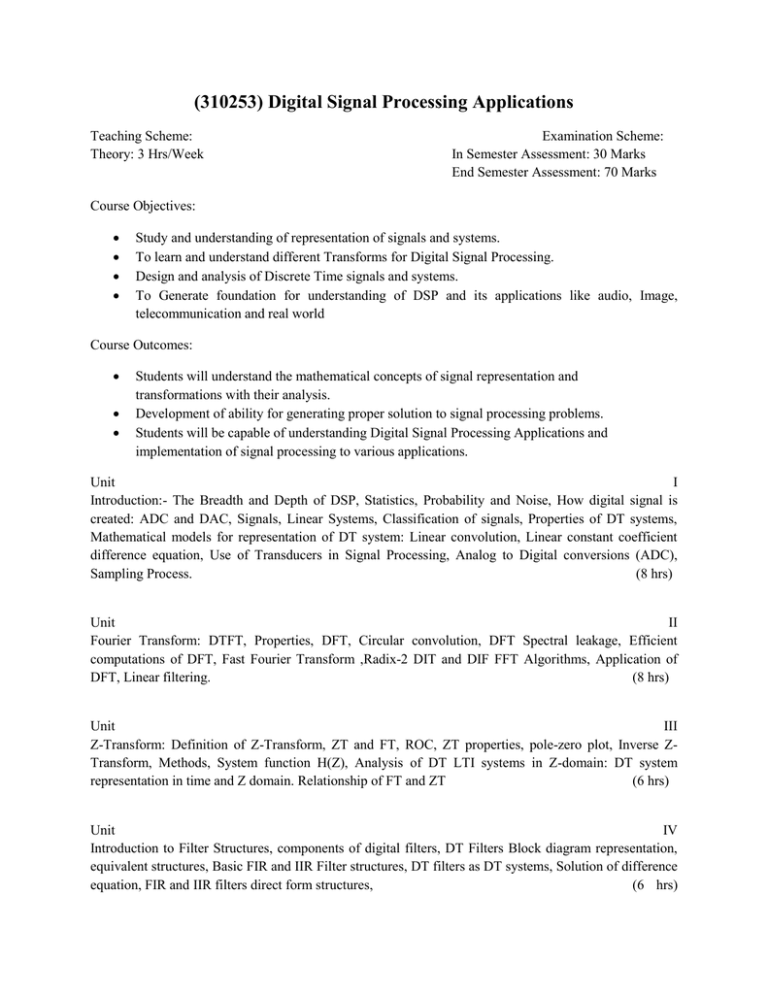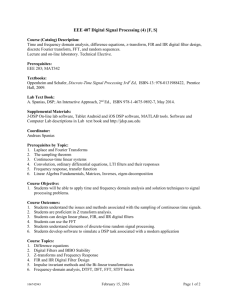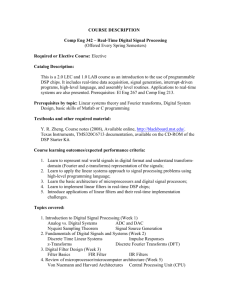Syllabus - WordPress.com
advertisement

(310253) Digital Signal Processing Applications Teaching Scheme: Theory: 3 Hrs/Week Examination Scheme: In Semester Assessment: 30 Marks End Semester Assessment: 70 Marks Course Objectives: Study and understanding of representation of signals and systems. To learn and understand different Transforms for Digital Signal Processing. Design and analysis of Discrete Time signals and systems. To Generate foundation for understanding of DSP and its applications like audio, Image, telecommunication and real world Course Outcomes: Students will understand the mathematical concepts of signal representation and transformations with their analysis. Development of ability for generating proper solution to signal processing problems. Students will be capable of understanding Digital Signal Processing Applications and implementation of signal processing to various applications. Unit I Introduction:- The Breadth and Depth of DSP, Statistics, Probability and Noise, How digital signal is created: ADC and DAC, Signals, Linear Systems, Classification of signals, Properties of DT systems, Mathematical models for representation of DT system: Linear convolution, Linear constant coefficient difference equation, Use of Transducers in Signal Processing, Analog to Digital conversions (ADC), Sampling Process. (8 hrs) Unit II Fourier Transform: DTFT, Properties, DFT, Circular convolution, DFT Spectral leakage, Efficient computations of DFT, Fast Fourier Transform ,Radix-2 DIT and DIF FFT Algorithms, Application of DFT, Linear filtering. (8 hrs) Unit III Z-Transform: Definition of Z-Transform, ZT and FT, ROC, ZT properties, pole-zero plot, Inverse ZTransform, Methods, System function H(Z), Analysis of DT LTI systems in Z-domain: DT system representation in time and Z domain. Relationship of FT and ZT (6 hrs) Unit IV Introduction to Filter Structures, components of digital filters, DT Filters Block diagram representation, equivalent structures, Basic FIR and IIR Filter structures, DT filters as DT systems, Solution of difference equation, FIR and IIR filters direct form structures, (6 hrs) UnitV DSP Processors:DSP Building Blocks, Data Acquisition, Fix Point and Floating Point Implementation the SHARC floating Point processor, SIMD Micro Architecture and Instructions, Operating systems, MicroArchitecture consideration, Implementation Options, Intrinsic and Data type, OMAP (Open Multimedia Application Platform), DSP Applications: DSP and its benefits, Application areas, Key DSP operations, DSP processors, real world, audio, telecommunication applications and biomedical applications. (Ref: Reference Book No 3, Chapter 1, Page Nos: 1 to 36) (6 hrs) Unit VI DSP in Speech Processing & Image Processing: Audio Processing: Human Hearing, Timbre, Sound Quality Versus Data rate, High Fidelity Audio, Companding, Speech Synthesis and Recognition, Non Linear Audio Processing, Image Foundation and Display: Digital Image Structure, Cameras and Eyes, Television Video Signals, Other Image Acquisition and display, Brightness and Contrast Adjustments, Gray Scale Transforms, (Ref: Text Book No 1, Chapter 22,23, Page Nos: 351 to 386 ) (6 hrs) Text Books 1. Steven W. Smith, “The Scientist and Engineer's Guide to Digital Signal Processing”,California Technical Publishing, 2nd Edition, PDF ISBN 0-9660176-6-8. (Colleges are expected to purchase Paperback Edition ISBN 0-9660176-4-1) 2. “Digital Signal Processing “ , Third Ed. Prentice Hall ISBN 81-203-0720-8 3. “Digital signal processing A practical approach” Second Ed. by Emmanuel Ifeachor , Barrie W Jervis ; Pearson Reference Books 1. Lyla B. Das Embeded systems and Integrated Approach PEARSON ISBN 978-81-317-8766-3 (Chapter number 15 only) 2. Peter Barry and Patric Crowley Modern Embedded Computing, Elsevier ISBN 978-93-81269-77-0 (Chapter number 11 only) 3. “Digital Signal Processing - A Computer Based Approach”, Sanjit K Mitra Third Ed. TMH 4. “Electrical and Electronic Measurements and Instrumentation “ A. K. Sawhney- Dhanpat Rai and Sons, Delhi -2002 Print Digital Content: Developed by the BoS





